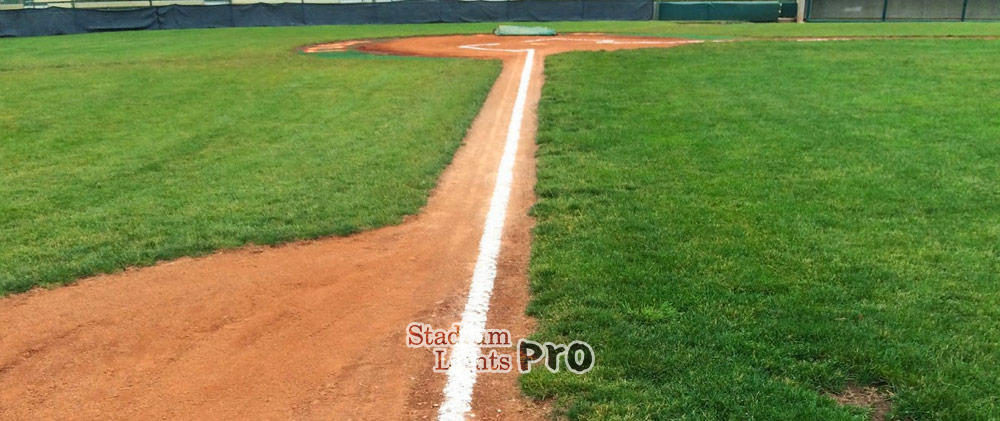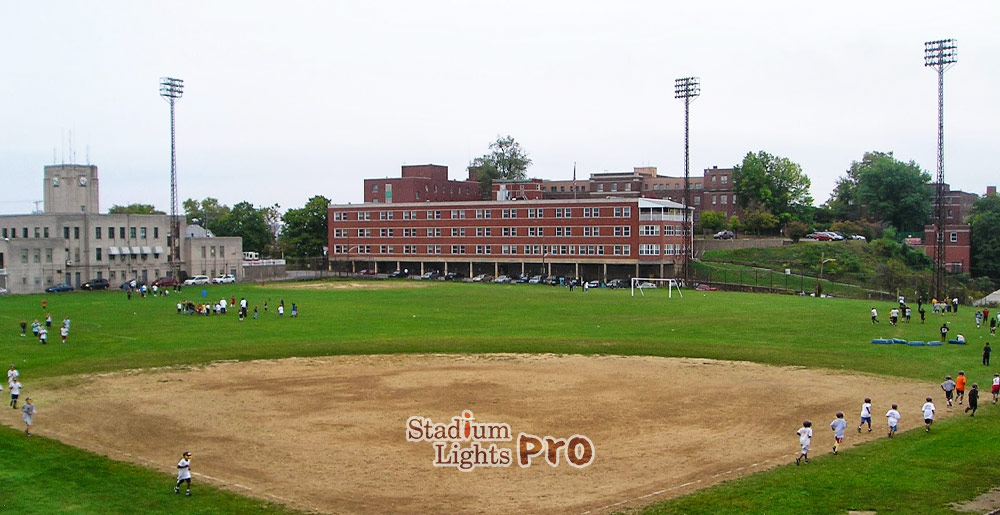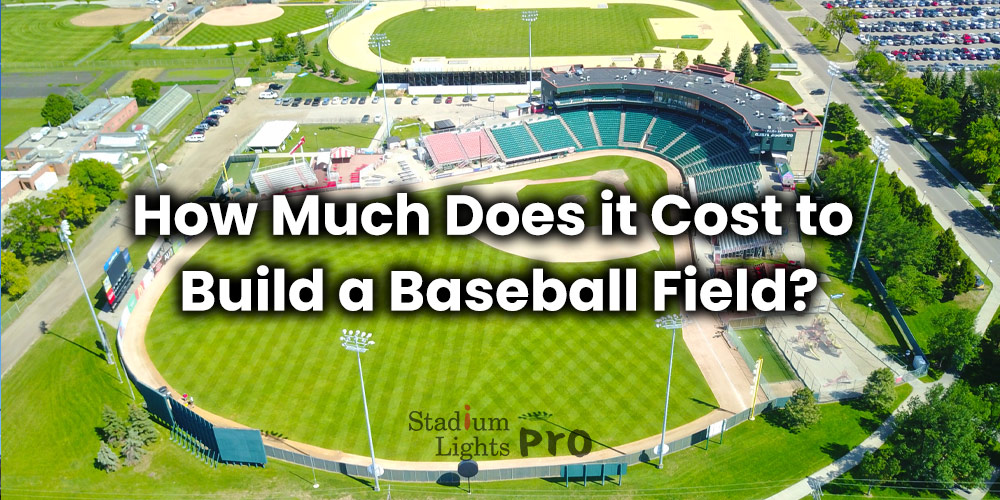Baseball is a beloved American pastime, and having a well-maintained baseball field is essential for players and fans alike. However, building a baseball field can be a significant undertaking, and it’s essential to consider all the costs involved before embarking on this project. In this article, we’ll provide an overview of the costs associated with building a baseball field, as well as tips for reducing those costs and factors to consider when determining the budget for your project. Whether you’re building a field for your community, school, or personal use, this guide will help you understand the costs and plan accordingly.
Table of Contents
ToggleComponents of baseball field construction cost
Land

The cost of the land for a baseball field can vary widely depending on a number of factors, including location, size, and availability. In urban areas, land may be more expensive due to higher demand, while in rural areas, land may be less expensive. The size of the land will also affect the cost, with larger plots of land generally costing more than smaller ones.
It’s difficult to provide an average range for the cost of land for a baseball field, as it can vary so widely. However, as a rough estimate, the cost of land could be anywhere from $3,000 to $8,000 for a small plot in a rural area, to hundreds of thousands or even millions of dollars for a larger plot in an urban area.
Site preparation
Site preparation refers to any grading, leveling, or other work that needs to be done to prepare the land for construction of a baseball field. The cost of site preparation will depend on the complexity of the project, as well as the materials and labor needed.
As a rough estimate, the cost of site preparation could be anywhere from a few thousand dollars for a small, simple project, to tens of thousands of dollars or more for a larger, more complex project.
Materials
Materials may include turf or clay for the field, fencing, dugouts, and other amenities. The size and quality of the materials will affect the overall cost of the project.
Some common materials that may be used in the construction of a baseball field include:
Artificial turf
Artificial turf is a popular choice for baseball fields, as it is relatively low maintenance and can be used year-round. However, it can be expensive to install and may require frequent replacement.
The cost of installing artificial turf on a baseball field will depend on the size of the field, the quality of the turf, and the complexity of the project. As a rough estimate, the cost of installing artificial turf on a baseball field could be anywhere from $30,000 to $100,000 or more, depending on the specific factors mentioned.
The initial cost of installing artificial turf is only part of the equation. Artificial turf may require frequent replacement, with a lifespan of 8-12 years on average. This means that the long-term cost of ownership may be higher than other materials, such as natural grass.
By considering the initial cost and long-term cost of ownership, you can make an informed decision about whether artificial turf is the right choice for your baseball field.
Natural grass

Natural grass is relatively low maintenance and can last for many years with proper care. However, it can be more expensive to install than artificial turf, and may require more maintenance over time.
The cost of installing natural grass on a baseball field could be anywhere from $10,000 to $50,000 or more.
Natural grass fields require ongoing maintenance, including mowing, watering, and fertilizing, which can add to the long-term cost of ownership.
Clay
Clay is often used in the construction of baseball fields, particularly for the infield. It can be expensive, but is durable and requires minimal maintenance.
As a rough estimate, the cost of installing clay on a baseball field could be anywhere from $5,000 to $20,000 or more.
Clay may require occasional maintenance, such as re-grading or moisture control, which can add to the long-term cost of ownership.
Fencing
Fencing is often used to enclose a baseball field and may be made of wood, vinyl, or other materials. The cost of fencing will depend on the size of the field and the material used.
As a rough estimate, the cost of installing fencing on a baseball field could be anywhere from $500 to $10,000 or more, depending on the size of the field and the type of fencing used. For example, a small, basic fence made of wood or vinyl may cost $500-$1,500, while a larger, more complex fence made of metal or stone may cost $10,000 or more.
Dugouts
Dugouts are shelters for the players and may be made of wood, concrete, or other materials. The cost of dugouts will depend on the size and material used.
The estimated cost of installing dugouts on a baseball field could be anywhere from $5,000 to $20,000 or more, depending on the size of the dugouts and the material used. For example, a small, basic dugout made of wood or concrete may cost $5,000-$10,000, while a larger, more complex dugout made of metal or stone may cost $10,000 or more.
Labor
The cost of labor will be a significant factor when building a baseball field. If you hire professional contractors to build the field, you will have to pay for their labor. If you build the field yourself, you will not have to pay labor costs, but you will have to invest your own time and effort into the project.
It’s difficult to provide an accurate estimate of the cost of labor for building a baseball field, as it will depend on the size and complexity of the project, as well as the hourly rate of the contractors or workers.
The expected cost of labor could be anywhere from a few thousand dollars for a small, simple project, to tens of thousands of dollars or more for a larger, more complex project.
Equipment
You may need to purchase or rent equipment, such as bulldozers, backhoes, and other heavy machinery, to complete the construction of a baseball field. The cost of equipment will depend on the size and complexity of the project, as well as the type and duration of the equipment rental.
Lighting system

A lighting system can be a useful addition to a baseball field, as it allows for games or practices to be held at night or in low light conditions. However, installing a lighting system can be complex and expensive.
The average cost of installing a lighting system on a baseball field will depend on the size of the field, the quality of the lighting, and the complexity of the project. The cost of installing a lighting system on a baseball field could be anywhere from $10,000 to $50,000 or more
Drainage system
A proper drainage system is essential for a baseball field, as it helps to prevent standing water and muddy conditions on the field. Installing a drainage system can be complex and expensive, but is necessary for the long-term success of the field.
The expenses of installing a drainage system on a baseball field could be anywhere from $5,000 to $20,000 or more, depending on the specific factors mentioned.
Logo and design of baseball diamond
The logo and design of the baseball diamond, which includes the layout of the field and any decorative elements, can be a factor that affects the cost of building a baseball field. A more complex or elaborate design may require additional materials and labor, which can increase the cost of the project.
The cost of the logo and design could be anywhere from a few hundred dollars for a basic, simple design, to several thousand dollars or more for a more complex or elaborate design.
Utilities
The cost of utilities, such as electricity and water, may be a factor when building a baseball field. The specific utilities needed will depend on the size and amenities of the field, as well as the location.
The cost of utilities will vary depending on the specific needs of the field and the rates charged by the utility provider.
Maintenance
Maintenance is an ongoing cost that should be considered when building a baseball field. Maintenance tasks may include mowing, watering, fertilizing, and other upkeep tasks. The cost of maintenance will depend on the size of the field, the materials used, and the frequency of the tasks.
The expenses of maintenance for a baseball field could be anywhere from a few hundred dollars per year for a small, simple field, to several thousand dollars or more per year for a larger, more complex field.
Estimated costs for building a baseball field
There are many variables to consider, and the actual cost of building a baseball field may vary depending on your specific needs and circumstances.
Here are some assumptions that we will make in order to provide an estimate:
- The baseball field will be a small, amateur field, with a size of approximately 50×100 feet.
- The field will be located in a suburban area, with easy access to materials and labor.
- The field will be built with natural grass, with a clay infield and gravel warning track.
- The baseball field will include a basic fence, two dugouts, and a lighting system.
- It will be built with the help of professional contractors.
Based on these assumptions, here is an estimated cost breakdown for building a baseball field:
| Baseball field items | Estimated cost |
| Land | $10,000 |
| Site preparation | $5,000 |
| Materials (grass, clay, gravel, fence, dugouts) | $15,000 |
| Labor | $20,000 |
| Equipment | $2,000 |
| Lighting system | $15,000 |
| Drainage system | $10,000 |
| Logo and design | $1,000 |
| Utilities | $1,000 |
| Maintenance | $1,000 |
| Total cost | $80,000 |
Again, these are just rough estimates, and the actual cost of building a baseball field may vary depending on your specific needs and circumstances.
Factors that affect the cost of building a baseball field
Size of the field
A larger field will require more materials and labor to construct, which will increase the overall cost. The size of the field will also impact the cost of maintaining the field, as a larger field will require more resources for upkeep.
There are several standard sizes for baseball fields, with the most common being a regulation field that measures 325 feet down the foul lines and 400 feet to center field. However, fields can be built to accommodate players of different ages and skill levels, and may be smaller or larger than a regulation field.
Keep in mind that building a larger field will not only increase the upfront costs of construction, but may also result in higher long-term maintenance costs.
Quality of materials
The quality of materials used to build a baseball field will also affect the overall cost. Higher quality materials, such as professional-grade turf or clay, may be more expensive, but they may also be more durable and require less maintenance over time.
For example, artificial turf fields are becoming increasingly popular, as they are relatively low maintenance and can be used year-round. However, they can be expensive to install and may require frequent replacement. Natural grass fields, on the other hand, require more maintenance, but may be less expensive to install and can last for many years with proper care.
When choosing materials for your baseball field, we need to consider the long-term cost of ownership, as well as the intended use of the field. Factors such as the number of games played, the climate, and the amount of available maintenance resources should all be taken into account. By considering the quality of materials and their long-term cost, you can make an informed decision that will help ensure the success of your baseball field.
Location
Building a field in an urban area may be more expensive due to higher labor and material costs, while building in a rural area may be less expensive.
Transportation
Shipping materials and equipment to the construction site may be more expensive in certain locations.
Regulations
Different cities and states have different building codes and regulations that must be followed when constructing a baseball field. These regulations may impact the cost of the project.
Utilities
The availability and cost of utilities, such as electricity and water, may vary depending on the location of the field.
Land
The cost of the land itself can vary widely depending on the location.
Who is building the field
Hiring professional contractors to build the field will typically be more expensive than doing it yourself, but it may also result in a higher quality end product.
There are pros and cons to both approaches. If you choose to hire professional contractors, you can expect a higher level of expertise and experience, as well as a more efficient and timely construction process. However, this option will be more expensive, as you will have to pay for the contractors’ labor and materials.
If you choose to build the field yourself, you may be able to save on labor costs, but you will have to invest more time and effort into the project. You may also have to purchase or rent equipment and materials, which can add to the cost.
Tips for reducing the cost of building a baseball field
Using recycled materials
Using recycled materials can be a good way to save money when building a baseball field. Recycled materials are often less expensive than new materials, and using them can help reduce waste and have a positive environmental impact.
There are many types of recycled materials that can be used in the construction of a baseball field, including recycled turf, recycled fencing, and recycled dugouts. The availability and cost of recycled materials will vary depending on your location and the specific materials you are looking for.
Using energy-efficient baseball field lighting system
Energy-efficient lighting systems use less electricity, which can help lower utility bills and reduce your carbon footprint.
There are many types of energy-efficient lighting systems available for baseball fields, including LED lighting and high-efficiency metal halide lighting. The cost of energy-efficient lighting systems will depend on the size and complexity of the project, as well as the specific technology used.
Hiring local contractors
Local contractors are often more familiar with the local market and may be able to provide materials and labor at a lower cost than out-of-town contractors. Besides, hiring local contractors can help support the local economy and create jobs in the community.
To find local contractors, you can search online directories or ask for recommendations from friends, neighbors, or local business associations. It’s a good idea to get quotes from multiple contractors and compare the costs and services offered before making a decision.
Seeking grants or sponsorships
Seeking grants or sponsorships can be a good way to offset the costs of building a baseball field. Grants and sponsorships are typically given by organizations or businesses that are interested in supporting sports, recreation, or community projects.
There are many sources of grants and sponsorships for baseball fields, including local foundations, community organizations, and sports leagues. To find grants or sponsorships, you can search online directories, attend local events and networking functions, or contact organizations directly to inquire about funding opportunities.
Conclusion
The cost of building a baseball field can vary widely depending on the size and complexity of the project, as well as the materials, labor, and other costs involved. A small, amateur baseball field with basic amenities could cost anywhere from $10,000 to $50,000 or more, while a larger, professional-grade field with more amenities could cost hundreds of thousands of dollars or more.
There are many ways to save money when building a baseball field, including using recycled materials, hiring local contractors, and seeking grants and sponsorships. By considering these options and being proactive in controlling costs, you can help keep the overall cost of building a baseball field within your budget.
If you are interested in building a baseball field and would like some help with the design and planning process, we encourage you to contact us for a free consultation. Our team of experts has years of experience designing and building baseball fields, and we would be happy to provide you with guidance and advice to ensure that your field meets your needs and budget.
We offer a range of services, including field design, site preparation, materials selection, and construction management. Whatever your specific needs may be, we are here to help you every step of the way.
To get started, simply contact us and tell us a little bit about your project. We will be happy to provide you with a free design and consultation, and help you plan the perfect baseball field for your community.

